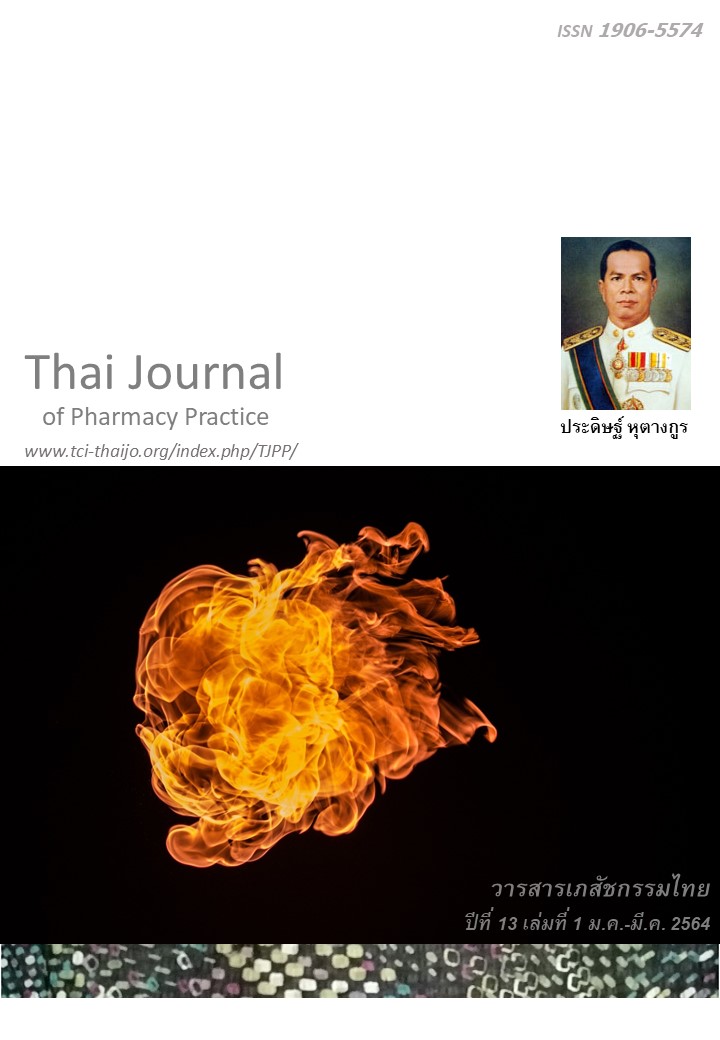ความชุกของเครื่องสำอางต้องสงสัยที่พบสารห้ามใช้ที่จำหน่ายในอำเภอชายแดนของเขตสุขภาพที่ 10
Main Article Content
บทคัดย่อ
วัตถุประสงค์: เพื่อศึกษา 1) ความชุกของเครื่องสำอางต้องสงสัยที่พบสารห้ามใช้ 3 ชนิด ได้แก่ ปรอทแอมโมเนีย ไฮโดรควิโนน และกรดเรทิโนอิค ที่จำหน่ายในอำเภอชายแดนของเขตสุขภาพที่ 10 2) ความรู้และพฤติกรรมในการจำหน่ายเครื่องสำอางของผู้ประกอบการ และ 3) ปัจจัยที่มีผลต่อการเลือกเครื่องสำอางมาจำหน่าย และช่องทางการซื้อเครื่องสำอางของผู้ประกอบการ วิธีการ: การวิจัยนี้เป็นการศึกษาภาคตัดขวางที่เก็บตัวอย่างเครื่องสำอางที่ต้องสงสัยในความปลอดภัย และไม่อยู่ในรายการเครื่องสำอางอันตรายในเว็บไซต์ของ อย. ระหว่างเดือน พฤษภาคม ถึง กรกฎาคม 2561 จากร้านค้า ร้านชำ ตลาดนัด และจุดผ่อนปรนใน 4 จังหวัดชายแดนได้แก่ อุบลราชธานี ศรีสะเกษ อำนาจเจริญ และมุกดาหาร ผู้วิจัยตรวจเครื่องสำอางตัวอย่างด้วยชุดทดสอบอย่างง่าย และใช้แบบสอบถามเก็บข้อมูลจากผู้ประกอบการ ผลการวิจัย: การตรวจสอบร้านจำหน่ายเครื่องสำอางทั้งสิ้น 39 ร้านพบเครื่องสำอางต้องสงสัยที่รับการตรวจ 69 รายการ จำนวนผลิตภัณฑ์ที่พบสารต้องห้ามอย่างน้อย 1 ชนิด คือ 31 รายการ (ร้อยละ 44.9) พบปรอทแอมโมเนีย 26 ตัวอย่าง (ร้อยละ 37.7) กรดเรทิโนอิค 10 ตัวอย่าง (ร้อยละ 14.5) และไฮโดรควิโนน 1 ตัวอย่าง (ร้อยละ 1.4) ตัวอย่างแสดงเลขที่ใบรับแจ้ง จำนวน 44 รายการ (ร้อยละ 63.8) ในจำนวนนี้ไม่พบเลขที่ใบรับแจ้งในระบบของ อย. จำนวน 2 รายการ (ร้อยละ 4.5) ผู้ประกอบการส่วนใหญ่มาจากร้านค้าและร้านชำ (ร้อยละ 64.1) ผู้ประกอบการซื้อเครื่องสำอางจากร้านค้าส่งมากที่สุด (ร้อยละ 61.5) แหล่งข้อมูลส่วนใหญ่ได้จากร้านขายส่งหรือตัวแทนจำหน่าย (ร้อยละ 64.1) ปัจจัยที่มีผลต่อการเลือกซื้อ คือ ประสิทธิภาพ (4.33±0.71 จากคะแนนเต็ม 5) รองลงมาคือ ความน่าเชื่อถือของแหล่งที่ซื้อ (4.31±0.69) สรุป: การศึกษาพบการปนเปื้อนของสารห้ามใช้สูงในเครื่องสำอางในอำเภอชายแดนของภาคตะวันออกเฉียงเหนือ สำนักงานสาธารณสุขจังหวัดที่เกี่ยวข้องควรต้องเฝ้าระวังเครื่องสำอางแม้จะมีเลขที่ใบรับแจ้งถูกต้อง เพราะยังสามารถตรวจพบสารห้ามใช้ได้ ผู้ประกอบการยังต้องได้รับการพัฒนาความรู้ให้เกิดความตระหนักในการจำหน่ายเครื่องสำอางที่ถูกต้องเพื่อลดการกระจายเครื่องสำอางที่ไม่ถูกต้องไปสู่ผู้บริโภค
Article Details
ผลการวิจัยและความคิดเห็นที่ปรากฏในบทความถือเป็นความคิดเห็นและอยู่ในความรับผิดชอบของผู้นิพนธ์ มิใช่ความเห็นหรือความรับผิดชอบของกองบรรณาธิการ หรือคณะเภสัชศาสตร์ มหาวิทยาลัยสงขลานครินทร์ ทั้งนี้ไม่รวมความผิดพลาดอันเกิดจากการพิมพ์ บทความที่ได้รับการเผยแพร่โดยวารสารเภสัชกรรมไทยถือเป็นสิทธิ์ของวารสารฯ
เอกสารอ้างอิง
Cosmetic Act B.E. 2558. Royal Gazette No. 132, Part 86A (Sep 8, 2015).
Wuttiadirek W, Phumkate V. Study of mercury levels in facial creams distributed in Nakhonsawan municipality area. FDA Journal 2016; 23: 28-31.
Food and Drug Administration. Super Poll: Health products’ label use behavior in population: full report for FDA [online]. 2019 [cited Nov 1, 2019]. Available from: db.oryor.com/databank/uploads/fda/ 0802388001571992568_file.pdf
Bureau of Cosmetics and Hazardous Substances. Annual report of Bureau of Cosmetics and Hazardous Substances in 2015. Nonthaburi: Depart ment of Medical Sciences. Ministry of Public Health, Thailand; 2015.
Bureau of Cosmetics and Hazardous Substances. Annual report of Bureau of Cosmetics and Hazardous Substances in 2016. Nonthaburi: Depart ment of Medical Sciences. Ministry of Public Health, Thailand; 2016.
Public and Consumers Affairs Division, Food and Drug Administration. Warning for counterfeit cosmetic products containing prohibited substances causing danger to facial skin. FDA Newsletter.2017; 83.
Ministry of Public Health. Prohibited substances name as an ingredient for cosmetic industrial. Royal Gazette No. 133, Part 114D (May 17, 2016).
Kiatying-Angsulee N, Prasertsuk S. What happen at the border?: steroid situations and popular hazardous drugs. Thai Drug Watch 2016; 8:3-24.
Saramon P, Ruengorn C, Seangphichai S, Wonghankla B. Epidemic of inappropriate health products and associated adverse events among chronic disease patients in border area, Wieng Kan District, Chiang Rai province. Thai Journal of Pharmacy Practice 2018; 11: 268-78.
Food and Drug Administration. News in Public Health [online]. 2019 [cited Jan 25, 2019]; Available from: pr.moph.go.th/?url=pr/detail/2/02/122436/.
Bureau of Cosmetics and Hazardous Substances, Department of Medical Sciences, Ministry of Public Health. Test kits [online]. 2019 [cited Jun 20, 2019]; Available from: www.dmsc.moph.go.th/cosmetics/th /services.php?id=1&sid=5.
Prasongkool K, Ruengorn C. Analysis of the situation on contamination of prohibited harmful substances in facial cosmetics In Amphur Nangrong, Buriram Province during 2013 -2016. Thai Journal of Pharmacy Practice 2017; 9: 361-9.
Anuwatworakul U. Needs for development of technical competencies in consumer protection in health products among officers of sub-district health promoting hospitals in Buriram. Thai Journal of Pharmacy Practice 2016; 8: 388-98.
Cosmetics Information Center, Bureau of Cosmetics and Hazardous Substances, Department of Medical Sciences. Ministry of Public Health. Cosmetics containing prohibited substances [online]. 2019 [cited Jun 20, 2019]. Available from: webdb.dmsc .moph.go.th/ifc_cosmetic/news/cos_ 0951/cos_10 02.htm.
Udomkitti M, Harnpanichjaroen M. Cosmetics label evaluation for community economy in Ubon Ratchathani province. Isan Journal of Pharmaceu tical Sciences 2014; 9 (Supplement): 181.


